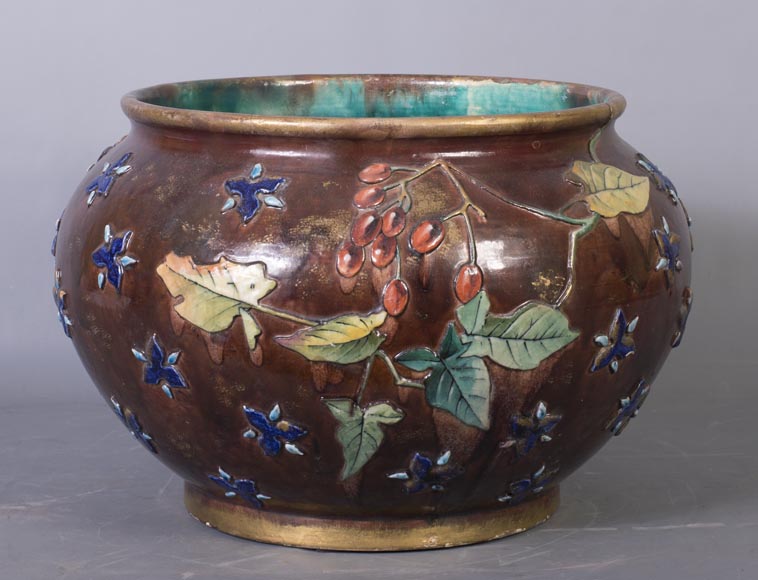Style Other / Ref.11429
Fernand THESMAR, Ceramic gardener with applied enamel flowers decoration
Dimensions
Height 9'' 23cm
diameter: 14'' ⅛ 36cm
Origin:
19th century.
Status:
Good condition.
This important gardener bears the monogram of the enameler André-Fernand Thesmar (1843-1912), and was made in the beginning of his enemaler career when he discovers the enamel work and starts his first tries in the 1870's.
Andre-Fernand Thesmar first devoted himself to oil painting and was known as a painter of flowers. He was educated in drawing in a factory for printed-fabric in Mulhouse where he had been placed at fourteen years old to learn the trade of a draftsman. His teacher was a painter of flowers: he “drew and dissected the plant with fury, requiring an anatomical analysis of shapes and a meticulous copy of nature.” He left this industrial environment to go to Paris in 1860 and engaged in various activities. It was probably for his talent as a painter that Thesmar was noticed in 1872 by Ferdinand Barbedienne. With Barbedienne, later Thesmar succeeded to the management of the production of enamels. The productions of Thesmar and Barbedienne reflected the interest that they had for the decorative techniques and compositions of Japanese enamel. It was as “co-operator of the Barbedienne company” that Thesmar exhibited at the Exhibition of Decorative Arts in 1874, A cock pheasant from China. At the exposition in 1875, Thesmar exhibited two large enamel compositions on copper.
In 1891, Thesmar turned to the decoration of porcelain and introduced himself to Charles Lauth who, since 1879, led the Factory de Sèvres. Its at this time that the collaboration with the Barbedienne company ended. Afterwards, he would be especially known for having invented the “plique à jour” technique, which numerous pieces of are kept in public collections.
He creates here a very beautiful gardener with a brown background on which is detaching a floral decoration, favorite theme of the artist, in light relief with applied enamel. His study of the botany allows him to create decor of which the flower speciment are easily recognizable. For instance, we can identify here on one face yellow bindweed as flowered rosemary. On the ohter side he depicts holly. Finally on the whole a rain of aquilegias put randomly on the surface.
Informations
Price: on request
Recommended for you :
Dimensions:
Diameter: 36
Dimensions:
Diameter: 52
Dimensions:
Width: 20
Height: 34
Depth: 13
Dimensions:
Width: 22
Height: 76
Depth: 22
Dimensions:
Height: 10
Diameter: 36
Dimensions:
Width: 34
Height: 12
Depth: 34
Dimensions:
Diameter: 24
Dimensions:
Width: 33
Height: 26
Dimensions:
Width: 25
Height: 48
Dimensions:
Height: 26
Diameter: 36
Dimensions:
Width: 20
Height: 46
Depth: 17























